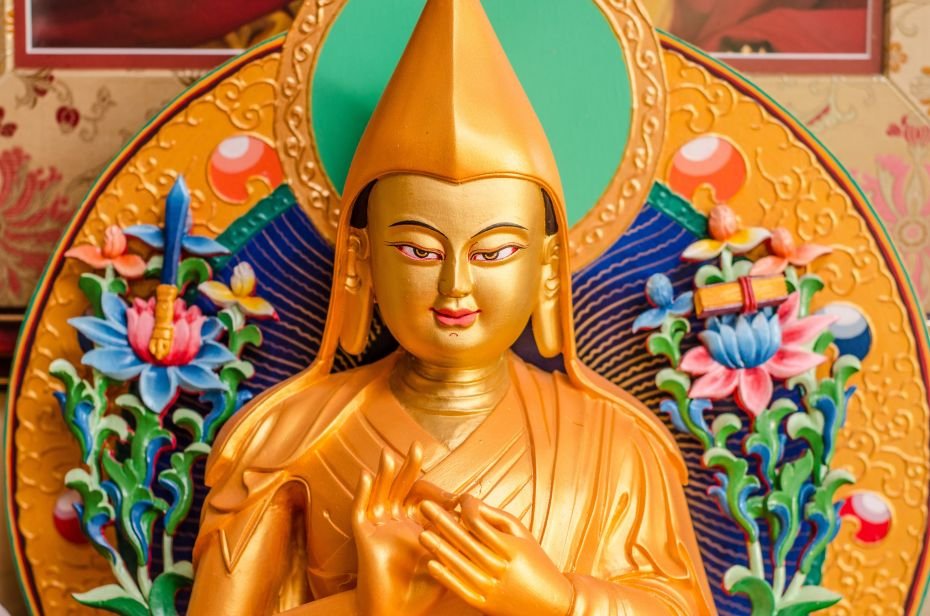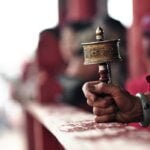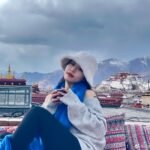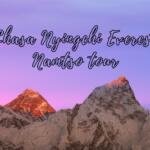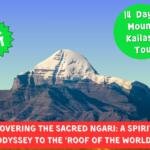The Remarkable Birth of Tsongkhapa: A Tale of Miracles and Prophecy
Tsongkhapa’s Auspicious Birth
In 1357, on the 25th day of the tenth lunar month, Tsongkhapa, a revered figure in Tibetan Buddhism, was born in what is now the area of Kumbum Monastery in Qinghai Province. Among his six siblings, he was the fourth.
A Miraculous Sign at Birth
At Tsongkhapa’s birth, a miraculous event occurred. As his umbilical cord was cut, a drop of blood fell to the ground and a sandalwood tree sprang up. This tree, bearing 100,000 leaves, had images of the Lion’s Roar Buddha on one side and the mantra of Manjushri, “Om Ara Pa Tsa Na Dhi,” on the other. This tree, akin to the Bodhi tree under which Buddha attained enlightenment, symbolized Tsongkhapa’s extraordinary destiny.
The Dharma Name “Lobsang Drakpa”
Dondrub Rinchen, Tsongkhapa’s spiritual mentor, followed the teachings of Lobsang Drakpa, an earlier master renowned for his accomplishments in Tibet’s Ngari region. This earlier Lobsang Drakpa prophesied the emergence of a great being, also named Lobsang Drakpa, who would come forth to rescue sentient beings and rejuvenate Tibetan Buddhism. He predicted the imminent birth of this prophesied being.
Subsequently, he instructed Dondrub Rinchen to travel to Amdo (near the current location of Kumbum Monastery) to await Tsongkhapa’s birth. He believed Tsongkhapa to be an incarnation of Manjushri. Dondrub Rinchen was to nurture Tsongkhapa and bestow upon him the monastic vows and the name “Lobsang Drakpa.”
Tsongkhapa: A Remarkable Birth Marked by Prophecy and Miracles
The Auspicious Arrival of Tsongkhapa
In the year 1357, a significant event occurred in the region now known as Kumbum Monastery in Qinghai Province. On the 25th day of the tenth lunar month, a child was born who would become a pivotal figure in Tibetan Buddhism. Named Tsongkhapa, he was the fourth among seven siblings, destined to leave an indelible mark on Buddhist teachings.
A Miraculous Sign at Tsongkhapa’s Birth
The birth of Tsongkhapa was accompanied by an extraordinary phenomenon. As his umbilical cord was severed, a single drop of blood fell to the earth, and from it, a sandalwood tree miraculously grew. Remarkably, this tree bore 100,000 leaves, each leaf graced with sacred images. On one side, leaves depicted the Lion’s Roar Buddha, and on the other, the powerful mantra of Manjushri – “Om Ara Pa Tsa Na Dhi.” This event was seen as a symbol of Tsongkhapa’s unique destiny, reminiscent of the Bodhi tree under which Buddha achieved enlightenment.
The Bestowal of the Name “Lobsang Drakpa”
In Tsongkhapa’s early life, he was under the tutelage of Dondrub Rinchen, a student of the respected Lobsang Drakpa from Tibet’s Ngari region. The elder Lobsang Drakpa, renowned for his wisdom and spiritual achievements, had prophesied the arrival of a great being, also named Lobsang Drakpa. This great being was destined to play a pivotal role in saving sentient beings and revitalizing Tibetan Buddhism.
Believing Tsongkhapa to be an incarnation of the bodhisattva Manjushri, the prophecy led Dondrub Rinchen to Amdo, where he awaited Tsongkhapa’s birth to mentor him and bestow upon him the monastic vows and the name “Lobsang Drakpa.”

The Fulfillment of Tsongkhapa’s Prophetic Birth
Vision of Mahakala and Tsongkhapa’s Ordination
In the serene vicinity of Amdo, Dondrub Rinchen, engaged in deep retreat, experienced a vision. The deity Mahakala appeared to him, heralding the birth of Tsongkhapa on that very day. Upon Tsongkhapa’s birth, Dondrub Rinchen conducted several rituals, bestowing gifts upon the family and expressing his desire to guide the young Tsongkhapa. Recognizing the auspicious signs, Tsongkhapa’s parents entrusted him to Dondrub Rinchen. At the age of seven, Tsongkhapa was formally ordained and given the significant name “Lobsang Drakpa,” marking the beginning of a path filled with spiritual depth and enlightenment.
This narrative of Tsongkhapa’s early years intertwines prophetic visions and miraculous events, foretelling his profound impact on Tibetan Buddhism.
Tsongkhapa’s Journey to Enlightenment in Tibetan Buddhism
Tsongkhapa’s Formative Years
Embarking on a spiritual quest at the age of sixteen, Tsongkhapa entered the heart of Tibet to deepen his understanding of Buddhism. By twenty-nine, he fully committed to the monastic path, receiving Bhikshu vows. Studying under over forty masters from diverse traditions like Kagyu, Nyingma, Sakya, Jonang, and Kadampa, Tsongkhapa’s exceptional grasp of Buddhist teachings distinguished him among the hundreds of thousands of monks across Tibet’s major monasteries.
Intensive Practice and Profound Teachings
Tsongkhapa’s spiritual odyssey was characterized by rigorous study and practice. At thirty-eight, he embarked on a retreat with eight disciples in Woka Cholung. Here, he devoted himself to intensive practices, including 100,000 mandala offerings and millions of prostrations. His retreat culminated in a significant vision of the Thirty-Five Buddhas bestowing blessings upon him.
Tsongkhapa: Revitalizing Tibetan Buddhism and Realizing the Essence of Emptiness
Strengthening Monastic Discipline
In the era of Tsongkhapa, Tibetan Buddhism grappled with laxity in monastic discipline. The issue was widespread: many monks donned robes without proper ordination, and the understanding of monastic precepts was superficial at best. Tsongkhapa took upon himself the task of reviving the monastic code. He skillfully merged the precepts of the Sravaka, Pratyekabuddha, and Bodhisattva traditions, thereby enhancing the discipline and integrity of monastic life across Tibetan monasteries.
Tsongkhapa’s Enlightenment: The Realization of Emptiness
At thirty-nine, Tsongkhapa ventured to Cholung in southern Tibet, where his enlightenment journey reached a pivotal moment. Under the guidance of Master Nankai Gyaltsen, he delved deep into the “Stages of the Path to Enlightenment.” This period of intense study laid the groundwork for his later seminal work, “The Great Treatise on the Stages of the Path to Enlightenment.” At forty-one, a profound debate with his disciple Gyaltsab Je crystallized his understanding of the ultimate truth – the intricate relationship between dependent origination and emptiness. Tsongkhapa’s “Praise for Dependent Origination” is a tribute to this realization, acknowledging it as the essential truth taught by the Buddha.
A Comprehensive Integration of Buddhist Practices
Tsongkhapa’s teachings fostered a harmonious integration of the Sutra and Tantra paths, forming a comprehensive system of practice. This approach significantly influenced the Gelug tradition in Tibetan Buddhism, shaping its spiritual teachings and practices and impacting a myriad of practitioners.
The Enduring Wisdom of Tsongkhapa in Tibetan Buddhism
Crafting Key Texts in Buddhism
Tsongkhapa’s intellectual and spiritual journey led to the creation of major Buddhist texts. At 46, inspired by the “Stages of the Sacred Teachings” and teachings of venerable translators like Sherap Gyaltsen, he composed the “Great Treatise on the Stages of the Path” (Lamrim Chenmo). This text synthesized the Kadampa teachings with the enlightenment path, offering an unparalleled interpretation of Buddhist doctrine.
By 49, at Dzongkar Monastery, Tsongkhapa authored the “Great Exposition of Secret Mantra.” This comprehensive text demystified the four classes of Tantra in Buddhism, clarifying misconceptions and guiding practitioners on the authentic Tantric path. His writings effectively merged the profound insights of the Perfection of Wisdom (Prajnaparamita) with the esoteric practices of Vajrayana (Tantric) Buddhism.
Tsongkhapa: Establishing Major Festivals and Monasteries in Tibetan Buddhism
Inauguration of the Great Prayer Festival
At the age of 53, Tsongkhapa initiated the Great Prayer Festival (Monlam Chenmo) at the Jokhang Temple in Lhasa. This grand event attracted thousands of monks and laypeople from diverse sects and regions, creating a melting pot of spiritual fervor and devotion. The festival was characterized by its elaborate offerings and profound teachings, marking a significant chapter in the annals of Tibetan Buddhism. Tsongkhapa’s emphasis during the festival on monastic discipline and ethics was a reflection of Buddha Shakyamuni’s teachings, aiming to revive the core values of Buddhism.
Founding of Ganden Monastery
The same year witnessed Tsongkhapa’s establishment of the Ganden Monastery near Lhasa, laying the foundation for the Gelug school. Rooted in the principles of the Kadampa tradition, Ganden was prophesied to be a beacon of joy and learning amidst the snowy mountains. According to legend, the monastery’s sixteen altars were miraculously constructed overnight by divine craftsmen, symbolizing the divine endorsement of Tsongkhapa’s endeavors. The founding of the Gelug school under Tsongkhapa’s guidance brought together the finest practices and teachings from various sects, forming a holistic and inclusive Buddhist tradition.
Tsongkhapa’s Parinirvana and Lasting Legacy
“Essence of Eloquence” and Expansion of Teachings
At 58, Tsongkhapa penned the “Essence of Eloquence on the Art of Interpretation,” a concise yet profound work complementing his earlier “Great Treatise.” This text was aimed at making the teachings more accessible and comprehensible. In his sixties, Tsongkhapa’s influence continued to grow as his disciples established key monasteries like Drepung and Sera, further disseminating Buddhist teachings across Tibet.
Tsongkhapa’s Passing and Enduring Influence
In 1419, Tsongkhapa’s earthly journey came to an end. Leaving behind a rich spiritual legacy, he entrusted his teachings to his chief disciple Gyaltsab Je. Tsongkhapa’s life was a testament to his unwavering commitment to knowledge, teaching, and spiritual practice, all dedicated to the flourishing of the Dharma. His journey epitomizes the essence of a true master, devoted to the expansion and enrichment of Buddhist teachings, leaving an indelible impact on Tibetan Buddhism and spiritual seekers worldwide.

